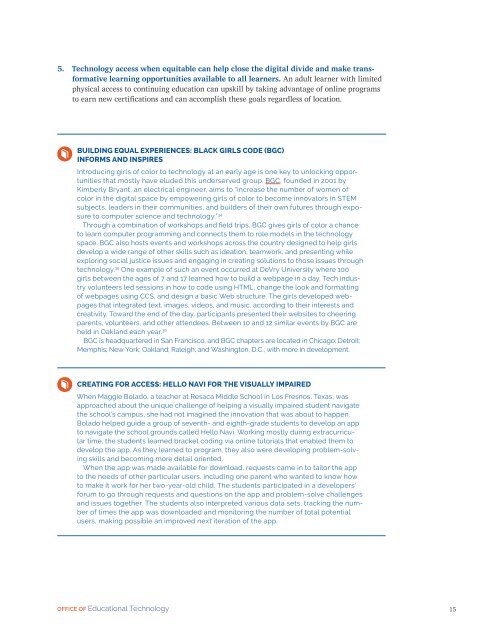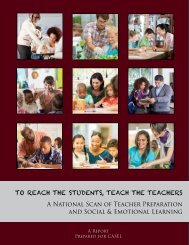Future Ready Learning
7m3sdJ
7m3sdJ
Create successful ePaper yourself
Turn your PDF publications into a flip-book with our unique Google optimized e-Paper software.
5. Technology access when equitable can help close the digital divide and make transformative<br />
learning opportunities available to all learners. An adult learner with limited<br />
physical access to continuing education can upskill by taking advantage of online programs<br />
to earn new certifications and can accomplish these goals regardless of location.<br />
BUILDING EQUAL EXPERIENCES: BLACK GIRLS CODE (BGC)<br />
INFORMS AND INSPIRES<br />
Introducing girls of color to technology at an early age is one key to unlocking opportunities<br />
that mostly have eluded this underserved group. BGC, founded in 2001 by<br />
Kimberly Bryant, an electrical engineer, aims to “increase the number of women of<br />
color in the digital space by empowering girls of color to become innovators in STEM<br />
subjects, leaders in their communities, and builders of their own futures through exposure<br />
to computer science and technology.” 34<br />
Through a combination of workshops and field trips, BGC gives girls of color a chance<br />
to learn computer programming and connects them to role models in the technology<br />
space. BGC also hosts events and workshops across the country designed to help girls<br />
develop a wide range of other skills such as ideation, teamwork, and presenting while<br />
exploring social justice issues and engaging in creating solutions to those issues through<br />
technology. 35 One example of such an event occurred at DeVry University where 100<br />
girls between the ages of 7 and 17 learned how to build a webpage in a day. Tech industry<br />
volunteers led sessions in how to code using HTML, change the look and formatting<br />
of webpages using CCS, and design a basic Web structure. The girls developed webpages<br />
that integrated text, images, videos, and music, according to their interests and<br />
creativity. Toward the end of the day, participants presented their websites to cheering<br />
parents, volunteers, and other attendees. Between 10 and 12 similar events by BGC are<br />
held in Oakland each year. 36<br />
BGC is headquartered in San Francisco, and BGC chapters are located in Chicago; Detroit;<br />
Memphis; New York; Oakland; Raleigh; and Washington, D.C., with more in development.<br />
CREATING FOR ACCESS: HELLO NAVI FOR THE VISUALLY IMPAIRED<br />
When Maggie Bolado, a teacher at Resaca Middle School in Los Fresnos, Texas, was<br />
approached about the unique challenge of helping a visually impaired student navigate<br />
the school’s campus, she had not imagined the innovation that was about to happen.<br />
Bolado helped guide a group of seventh- and eighth-grade students to develop an app<br />
to navigate the school grounds called Hello Navi. Working mostly during extracurricular<br />
time, the students learned bracket coding via online tutorials that enabled them to<br />
develop the app. As they learned to program, they also were developing problem-solving<br />
skills and becoming more detail oriented.<br />
When the app was made available for download, requests came in to tailor the app<br />
to the needs of other particular users, including one parent who wanted to know how<br />
to make it work for her two-year-old child. The students participated in a developers’<br />
forum to go through requests and questions on the app and problem-solve challenges<br />
and issues together. The students also interpreted various data sets, tracking the number<br />
of times the app was downloaded and monitoring the number of total potential<br />
users, making possible an improved next iteration of the app.<br />
OFFICE OF Educational Technology<br />
15



